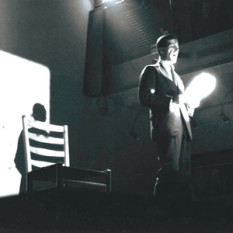Isidore Isou (January 31, 1925 – July 28, 2007), was a Romanian-born French poet, film critic and visual artist. He was the founder of Lettrism, an art and literary movement which owed inspiration to Dada and Surrealism.
Born into a Jewish family in Botoşani, Isou started his career as an avant-garde art journalist during World War II, shortly after the August 23 coup saw Romania joining the Allies (see Romania during World War II). With the future social psychologist Serge Moscovici, he founded the magazine Da, which was soon after closed down by the authorities. He moved to Paris, having developed many concepts that intended a total artistic renewal starting from the lowest levels. He called himself a Lettriste, a movement of which he was initially the only member (at the age of 16 he had published the Manifesto in 1942) and published a system of Lettrist hypergraphics. Others soon joined him, and the movement continues to grow, albeit at times under a confusing number of different names.
In 1951 the young Isou released his experimental and revolutionary film Traité de bave et d'éternité (Venom And Eternity), which some critics found revolting, and which became the Lettriste film manifesto. Attacking many film conventions by chipping away at them in his film, Isou introduced new concepts, including "discrepancy cinema" in which the sound track has little or nothing to do with the visual track. The sound track begins with jarring and unpleasant human noises, which continue in low volume even during spoken dialogue. In addition, the celluloid on which the film was recorded was attacked with destructive techniques such as scratches and bleaching. The film caused a scandal at the 1951 Cannes Film Festival, and was later introduced into the United States, where it influenced avant-garde film makers such as Stan Brakhage.
In the 1960s Lettrist, Lettrist-influenced works and Isidore Isou gained a great deal of respect in France. The influential writer Guy Debord and the artist Gil J. Wolman worked with Isou for a while, before breaking away to form the Lettrist International, which latter merged with the International Movement for an Imaginist Bauhaus, and the London Psychogeographical Association to form the Situationist International, a dissident revolutionary group. This is how Lettrist art influenced the posters, barricades, even clothing in the attempted revolution of 1968. Although it seemed a highly self-contained art in the post-war period, in 1968 it suddenly became more deeply involved in active social change than such movements as Existentialism and Surrealism, and came closer to producing actual transformation than these movements.
Isou's final public appearance was at the University of Paris on October 21, 2000. Crippled by ill health, he remained house-bound until his death in 2007. Many of his works, and those of the other Lettrists, have recently been reprinted in new editions, together with much hitherto unpublished material, most notably Isou's very large La Créatique ou la Novatique (1941-1976) (1,390 pages).
In July 2007, Kino International released a DVD collection Avant-Garde 2: Experimental Films 1928-1954 which included Isou's film Traité de Bave et d'Èternité (Venom and Eternity) (1951).
Published works:
Contre l'internationale situationniste (1960-2000), essai, Éd. Hors Commerce, 2000.
Contre le cinema situationniste, neo-nazi, Librairie la Guide, Paris, 1979.
Isou, ou la mécanique des femmes, Aux Escaliers de Lausanne, Lausanne (Paris), 1949.
Les Champs de Force de la Peinture Lettriste, Avant-Garde, Paris, 1964.
Introduction à une Nouvelle Poésie et une Nouvelle Musique, Paris, Gallimard, 1947.
La Créatique ou la Novatique (1941-1976), Éditions Al Dante, 2003.
Les Journaux des Dieus, 1950/51.
Manifesto of Lettrist Poetry: A Commonplaces about Words.
Traité de bave et d'éternité, Éd. Hors Commerce, 2000. .
All albums
You can find information through the best music search engine - Muzlan.top 😊All materials on request "Isidore Isou" are available on page Isidore Isou
Yes of course. You can listen tracks on the page Isidore Isou
Yes of course. You can download tracks on the page Isidore Isou
This page is found by queries: Isidore Isou song listen, Isidore Isou mp3 download, Isidore Isou track minus, Isidore Isou song download, Isidore Isou remix


